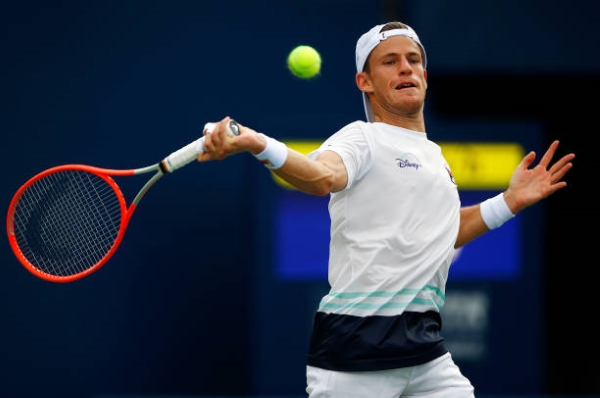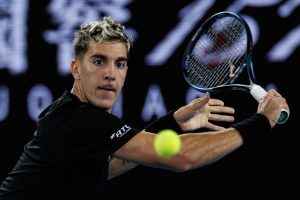I remember it like it was yesterday. Paris, October, 2020.
Diego Schwartzman was in a battle with Dominic Thiem in the quarterfinals of Roland Garros. Thiem had taken the third set in 8-6 in a tiebreak to go up two sets to one.
It felt to many as if Schwartzman’s chances at a maiden Slam semifinal had slipped through his fingertips. Yet, the Argentine wouldn’t be denied.
Schwartzman dug his heels in and fought. He tracked down nearly every bullet flying off of Thiem’s racquet. He hit with remarkable consistent depth and stepped up into the court to crack backhands. His forehand held up under pressure. And, Schwartzman didn’t seem to tire, feeding off the moment and the opportunity in front of him.
And it all paid off the Argentine. On match point, Thiem hit a drop shot into the net, prompting Schwartzman to lift his arms in the air and look triumphantly out at the crowd. He had come back to win 7-6 5-7 6-7 7-6 6-2 in the biggest match of his career.
And while Schwartzman ended up losing to Rafael Nadal in a respectable straight-sets defeat in the semifinals, he had proven to the world that he belonged.
Who cared that he was five foot, seven inches? He had plenty of heart.
***
Roland Garros 2020 couldn’t seem further away for Schwartzman during this 2022 season.
On the surface, it didn’t seem like a horrible season for the Argentine. After his Paris Masters’ loss to Maxime Cressy in the last non-ATP Finals/non-Davis Cup tournament of the season, he still had a 31-25 record (not including Laver Cup) on the year. Which, for a lot of players, would be a fantastic season.
But, Schwartzman was 25-15 in 2020. And 38-22 in 2021. He won no titles in 2022, last making a final in February, and losing in both of the finals he played this season.
And, after the French Open, things really started to go downhill for Schwartzman. The Argentine went 7-13 in his 20 matches (again, not including Laver Cup) post-Roland Garros, with his last victory occurring in the second round of the US Open over Alexei Popyrin.
In non-exhibitions, Schwartzman has lost his last six matches and his last seven sets. Schwartzman failed to win over 65% of his first-serve points in any of those six matches.
Schwartzman made one quarterfinal during the second half of his season, a 1-6 0-6 defeat to Pablo Carreno Busta in Bastad.
Diego Schwartzman in 2022: What Went Wrong?
So, what has gone wrong for Schwartzman? It’s a question I’ve constantly asked myself during his 2022 campaign and I’ve noticed a decline in three areas of his game.
First, Schwartzman’s backhand is not nearly the threat that it used to be. When Schwartzman was winning the ATP 500 title in Rio over Fernando Verdasco, he was not only able to absorb pace to his backhand wing, but also step up into the court and start dictating play from this wing when he got the opportunity to do so. Verdasco’s lefty forehand into Schwartzman’s backhand wasn’t an advantageous move for the Spaniard.
We don’t see that type of play nearly as often nowadays.
Second, Schwartzman’s forehand is declining. The forehand is less reliable than it used to be. He’s not as aggressive from this wing as he was in the past, preferring to just loop balls back into play. And opponents can rush him from his forehand side much more easily.
This encompasses both his backhand and forehand, but finally, Schwartzman has become less consistent this season. As I mentioned in regards to the 2020 Roland Garros Thiem match, at his best, the Argentine was an absolutely wall from the baseline. And he was getting excellent depth on his groundstrokes. Yet, this season as a whole, but especially in recent months, Schwartzman’s rally tolerance has plummeted.
Now, generally, when Schwartzman is able to stay consistent he still doesn’t have the depth-of-shot that he used to have, allowing opponents to tee off more often on his groundstrokes. And far too often we see him hit “random” errors that just weren’t present earlier in his career.
Now, subjectively, it does seem like the Argentine has lost of a bit of the passion and fire that he used to have. But, this is likely heavily correlated with the loss of confidence that consistent losses in an individual sport breeds.
So, now that the declining aspects of Schwartzman’s game has been identified, where does he go from here?
The off-season is coming at the perfect time for Schwartzman, allowing him to re-tool his game, along with giving his mind and body a rest from the stresses of competition.
Last Word on Tennis columnist Jethro Broughton has suggested that a new voice in Schwartzman’s camp would do him good, whether it be a new coach or just someone bringing a different perspective.
I agree that this could help freshen things up for Schwartzman, who is only 30 years old, although he does have to work especially hard due to his lack of free points on serve and, especially nowadays, given that he can’t rely on his backhand for outright winners nearly as often anymore.
Re-introducing those attacking groundstrokes into Schwartzman’s repertoire could do him worlds of good, especially if he isn’t physically as quick/durable as he was a couple years ago. He’s got to flatten out his backhand a bit more and try to dictate play like he used to. And, perhaps he can use this off-season to try to re-incorporate that into his game without further losing his consistency from the baseline.
While Schwartzman’s forehand was never a massive weapon, he could take a page out of Coco Gauff’s book, as she has done a great job of shoring up that side this season, increasing her rally tolerance from that wing and utilizing her forehand as a weapon when she gets a clear opening.
That’s what we used to see out of Schwartzman that isn’t present anymore. Nowadays, when someone pins Schwartzman in his forehand corner, it feels like a matter of time before the Argentine coughs up a short ball or unforced error.
I didn’t include this on my list of things noticeably declining because I don’t notice a huge difference in Schwartzman’s serve from before, but as I mentioned previously, he has not been doing much damage on his first serve recently. The off-season could help him re-work his serve placement to try to squeeze out some more free points.
However, it could just mean, for a player with the physical limitations that Schwartzman has (in a tennis context), that his “peak” tennis was short-lived and he can never return to the previous heights of his career.
And, if that’s the case, with four ATP Tour titles, four Slam quarterfinals, and a Slam semifinal, it’s still been an incredible run for Diego Schwartzman.
Main Photo from Getty.






